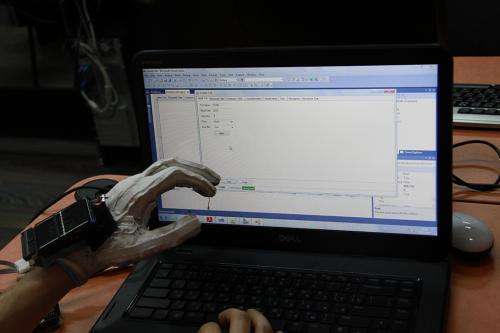July 11, 2012 report
Ukraine team wins Imagine Cup with gloves that convert sign language to speech

Bob Yirka
news contributor

(Â鶹ÒùÔº) -- For about a decade, Microsoft has been running a competition called the Imagine Cup that rewards people for developing innovative ideas using Microsoft products. This year the competition was held in Sydney Australia, and the winner in the software category was quadSquad from Ukraine for a system they call ; a truly unique and useful system that allows hearing impaired people who rely on sign language to communicate to those who can hear by employing a pair of sensor enabled gloves that are able to capture sign language gestures, translate them to text and then have the words spoken using a text-to-speech translator on a cell phone. For their efforts the team won $25,000 in prize money and likely the gratitude of millions once the gloves make it to market.
The gloves work through the use of five hardware components: flex sensors in the gloves record finger movements and a main controller coordinates information from an accelerometer/compass, an accelerometer/gyroscope, a microcontroller and a Bluetooth module. Windows mobile software was used to convert the gesture commands to sound signals for broadcast by the Bluetooth module. The sound waves are converted to voice using Microsoft Speech and Bing APIs running on a Smartphone, which ultimately serves as the voice for the person using the system. The team, made up of members identified as AntonStepanov, MaxOsika, Scizor60 and mentor dmitrtys, told the audience watching the demonstration of EnableTalk that the whole thing costs only about $50 per system (not including cell phone) and that they believe it could be brought down to $20 when mass produced. Conventional systems meant to pull off the same feat, but offer less sensitivity, typically run into the thousands of dollars.

The team said the idea for their system came from the frustration they experienced when trying to communicate with hearing impaired athletes at their school. They also noted that the system can be easily tweaked by the user to incorporate custom signs and thus can be used for virtually any sign language dialect. The point they say is to help those with hearing impairments better manage in the world of the hearing. The problem with sign language they point out, is that most people who can hear never learn it, thus those with hearing impairments are only able to communicate with a small part of the general population which generally includes those who cannot hear and those in their immediate circle. This new system they say, will allow those with hearing impairments to communicate with anyone.
Written for you by our author —this article is the result of careful human work. We rely on readers like you to keep independent science journalism alive. If this reporting matters to you, please consider a (especially monthly). You'll get an ad-free account as a thank-you.
© 2012 Â鶹ÒùÔº



















